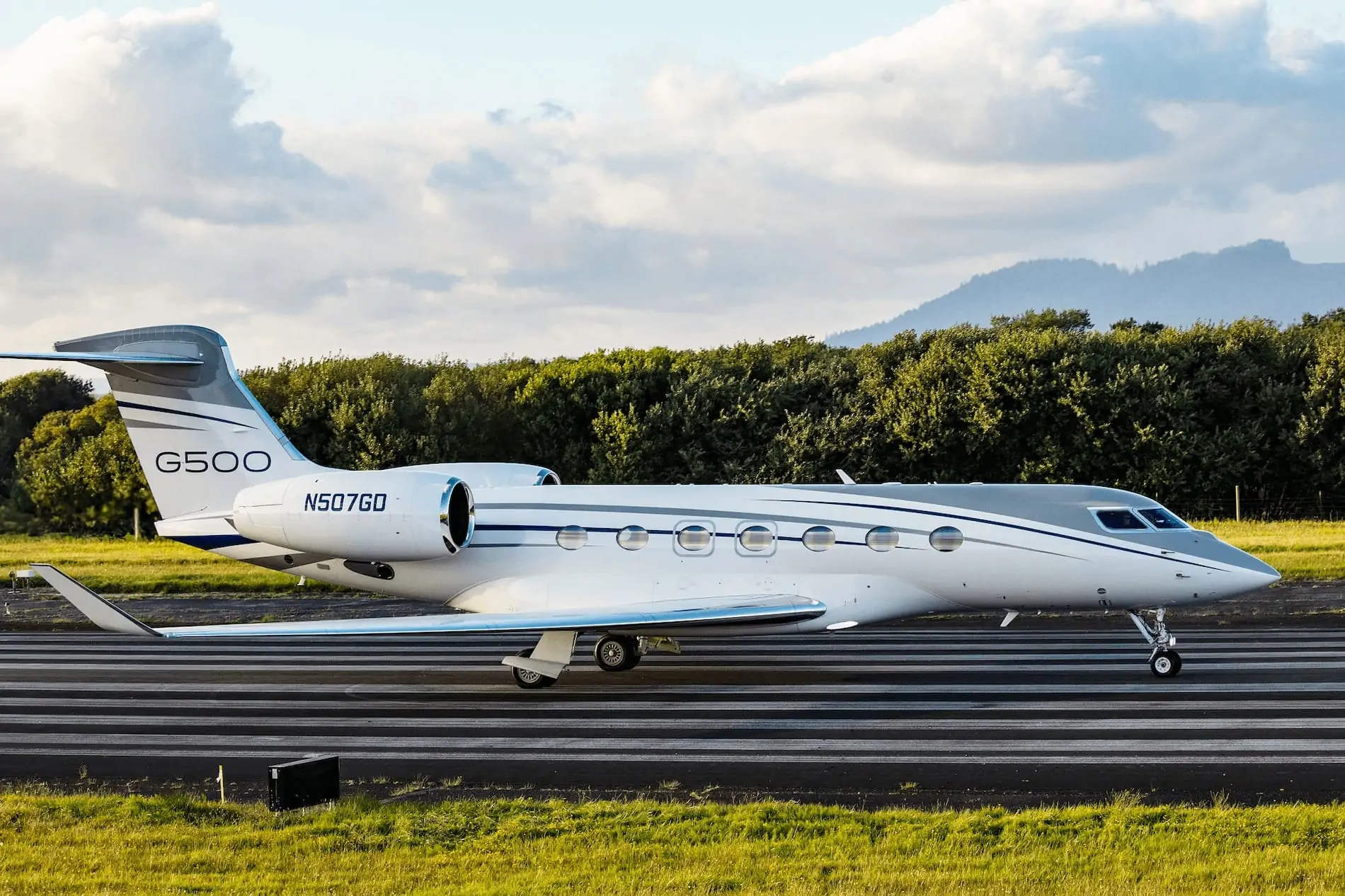The Gulfstream G500 and Gulfstream G700 are two of the newest Gulfstream aircraft in their lineup, along with the G600 of course.
While these aircraft have many similarities between them, there are some striking differences that separate these aircraft.
Therefore – how do you decide which aircraft is better? And, more importantly, which of these aircraft will suit your needs best?
Performance
When it comes to performance, both aircraft are evenly matched despite the G700 being the new Gulfstream flagship.
The Gulfstream G500 is powered by two Pratt & Whitney Canada PW814GA engines. Each engine is capable of producing up to 15,144 lbs of thrust. As a result, the total thrust output for the G500 is 30,288 lbs.
On the other hand, the Gulfstream G700 is powered by two Rolls-Royce Pearl 700 engines. Each engine is capable of producing up to 18,250 lbs of thrust. As a result, the total thrust output for the G700 is 36,500 lbs.
When it comes to altitude, both aircraft are able to cruise at up to 51,000 feet.
Additionally, the cruise speed of both aircraft is identical, topping out at 516 knots. This translates to a high-speed cruise speed of 0.90 Mach. For reference, Mach 1 is the speed of sound. Therefore, these are two of the fastest in-production business jets in the sky – only beaten by the Cessna Citation X and X+.
Despite the additional size of the G700, it is remarkably fuel-efficient. For example, the G500 has a fuel burn of just 353 Gallons per Hour (GPH). In comparison, the G700 burns 382 Gallons per Hour (GPH).
A difference of just 29 Gallons per Hour is extremely impressive given the additional size and power of the G700.
Range
When it comes to range the G500 never stood a chance against the G700. With the exception of the Bombardier Global 7500, the G700 has the longest range of any business jet.
For reference, the G500 is capable of flying up to 5,300 nautical miles (6,099 miles / 9,816 kms) without needing to refuel.
In comparison, the G700 is capable of flying up to 7,500 nautical miles (8,631 miles / 13,890 kms) without needing to refuel.
Visualize this range difference using our simple range tool.
Of course, as with every manufacturer stated range figures, these numbers are somewhat optimistic. However, that isn’t to take away from the incredible achievement that is the G700 range.
7,500 nautical miles is enough to fly non-stop from New York to Manila, Philippines.
Ground Performance
When assessing the take off distance of each aircraft, the results are hardly surprising. The Gulfstream G500 has a minimum take off distance of 5,300 feet. In comparison, the Gulfstream G700 has a minimum take off distance of 6,250 feet.
This, therefore, leads to the real world problem that some airports that can be accessed by the G500 can’t be reached by the G700. However, if flying long distances, more time will be saved through eliminating a fuel stop compared with reducing ground travel time.
However, when it comes to landing distance, the results are surprising with the G700 having a shorter minimum landing distance than the G500.
The G500 has a minimum landing distance of 3,100 feet. Whereas the minimum landing distance of the G700 is 2,500 feet.
While the benefits of a shorter landing distance are limited, this is extremely impressive.
Interior Dimensions
Given that the G700 is the largest aircraft in Gulfstream’s lineup, it is no surprise that it beats out the G500 in interior space.
Of course, one of the most notable differences between the G500 and G700 is the interior length. When it comes to interior length, the G500’s cabin measures 14.5 meters long. In comparison, the G700’s measures 17.35 meters in length.
Next up is interior width.The G500’s cabin measures 2.31 meters in width. In comparison, the G700’s cabin measures 2.49 meters wide.
Finally, cabin height. The G500’s cabin measures 1.88 meters in height. For reference, the G700 measures 1.91 in interior height.
While the difference in width and height are mere centimeters, it is a difference that will be noticed and appreciated by passengers. The aisle is slightly wider. There is slightly more headroom. Wider seats with more shoulder room.
Additionally, a longer cabin allows for more living areas. From a dedicated bedroom to shower, more comforts can be fitted into the G700.
Despite the smaller size of the G700, according to Gulfstream, both aircraft are capable of carrying up to 19 passengers.
And finally, baggage capacity. As you would expect, the G500 is unable to carry as much baggage as the G700.
The G500 can accommodate 175 cubic feet of luggage. Meanwhile, the G700 has space for up to 195 cubic feet of baggage.
Interior
Both aircraft are extremely modern. For reference, deliveries of the G500 began in 2018. Meanwhile, deliveries of the G700 are due to begin in 2022.
An area that is identical between these two area within the cabin is the cabin altitude. A lower cabin altitude will result in a more pleasant cabin environment and reduce the effects of jet lag.
However, somewhat surprisingly, both the G500 and G600 have identical cabin altitude figures. When cruising at 51,000 feet the cabin altitude of both aircraft will be 4,850 feet.
While this is an extremely low figure, it is not as low as the G650. This is a surprise given that the G700 is the new flagship aircraft. Therefore, one would expect the G700 to have a substantially lower cabin altitude that its predecessors.
Gulfstream G500
As with every Gulfstream, the G500 is wonderfully appointed. All the features you would expect on a long-range business aircraft are provided.
To begin with, the G500 has a tall and wide cabin which provides customers with greater design flexibility. For example, customers are presented with the option for a forward galley, rear gallery and a rear stateroom.
The tall and wide cabin provides lots of space for strolling down the wide aisle. All-new seats have been designed for maximum comfort.
100% fresh air, a maximum cabin altitude of 4,850 feet, and a cabin noise level of 50 decibels provide a peaceful environment. This environment is lit by fourteen signature Gulfstream oval windows. Combined, these windows provide an abundance of natural light and sweeping views of the world below. Adding these factors together ensures that you arrive at your destination refreshed and with minimal jet lag.
Gulfstream’s Cabin Management System allows passengers to control lighting, temperature, and media right from their seats. The seats are able to be converted to lie-flat beds. Therefore, the G500 is a great space to work, dine and relax.
G500




G700




Gulfstream G700
According to Gulfstream, the G700 features the tallest, widest and longest cabin in the industry. If you require a larger cabin you will be looking at the VIP airliners, such as the Boeing Business Jet (BBJ) or Embraer Lineage 1000E.
The aim of the G700 is to create the most comfortable environment possible in the sky so that you can sleep, work or relax as efficiently as possible. The G700 features true circadian lighting to simulate the sunlight of your next time zone to help reduce the effects of jet lag. Additionally, the G700 has a maximum cabin altitude of just 4,850 feet, one of the lowest cabin altitudes to be found on a private jet, helping you sleep better and reduce the effects of jet lag. Add in the extremely quiet cabin, you will have no trouble working, sleeping, or just relaxing.
Gulfstream has also fitted the G700 with twenty of the largest windows in business aviation, flooding the cabin with natural light to make the already large cabin feel even more spacious. As standard, the G700 features Jet Connex Ka-band Wi-Fi so that you can stay connected when you are in the air for hours at a time. The G700 features an all-new seat design that is handcrafted for each aircraft and can be converted to ergonomic beds.
The G700 has a maximum capacity of 19 passengers in a seating configuration and space for 13 passengers in a sleeping configuration. The cabin can be configured with up to five living spaces so you will always be able to get some privacy from your fellow passengers when on a long flight. See below for the various configurations you can have on a G700.
Charter Price
When it comes to chartering these aircraft the G500 is less expensive than the G700. Of course, this is unsurprising. However, please note that there are many factors that influence the price of a private jet charter. Therefore, prices will vary depending on the mission.
The estimated hourly charter price of the G500 is $7,350.
In comparison, the estimated hourly charter price of the G700 is $13,000. Note that the G700 is yet to hit the charter market, therefore this figure is a forward looking estimate.
Please do keep in mind that these prices are estimates only. There are a variety of factors that can and will influence the charter price of a private jet.
Purchase Price
And finally, how much does each aircraft cost to buy?
The Gulfstream G500 has a new list price of $45 million. In comparison the Gulfstream G700 has a new list price of $75 million.
Typically at this point in the comparison we would look at the pre-owned value of these aircraft. This is done because around 85% of all private jets are purchased pre-owned.
However, given that the G700 is yet to reach the pre-owned market, there is no data to provide a pre-owned value.
Although, if you are interested in purchasing a G500, a two year old model costs around $42 million according to Aircraft Bluebook.
This, therefore, represents excellent value, losing just $3 million over 2 years. This translates to a 93% retention of value.
Summary
To conclude, which one of these aircraft is best? Which one should you choose?
The G700 represents the best of the best. The very latest in Gulfstream and aviation technology. A large, capable aircraft that is hard to beat.
For flying long missions across multiple continents, the G700 is the aircraft to choose.
However, much like when comparing the G500 with the G650 or the G500 with the G600, Gulfstream have perfectly positioned each aircraft within their lineup.
If one aircraft can’t achieve your mission then you can easily step up to a larger aircraft that is more suitable. This, therefore, results in an aircraft family that can do it all.







